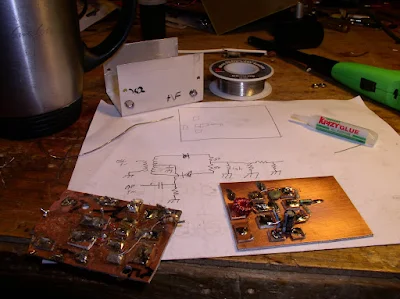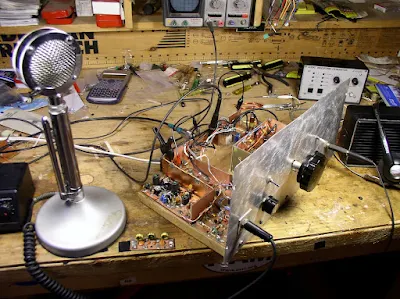
Our book: "SolderSmoke -- Global Adventures in Wireless Electronics"
http://soldersmoke.com/book.htm
Our coffee mugs, T-Shirts, bumper stickers: http://www.cafepress.com/SolderSmoke
Our Book Store: http://astore.amazon.com/contracross-20
Serving the worldwide community of radio-electronic homebrewers. Providing blog support to the SolderSmoke podcast: http://soldersmoke.com


 I hope to get a podcast out next week, but I've been suffering from a nasty headcold that would have introduced all kinds of weird audio effects.
I hope to get a podcast out next week, but I've been suffering from a nasty headcold that would have introduced all kinds of weird audio effects.  I'm not sure what I would do with an Arduino, but articles like this definitely make me want one! Here's one passage:
I'm not sure what I would do with an Arduino, but articles like this definitely make me want one! Here's one passage: Steve "Snort Rosin" Smith has been keeping me on the side of the angels (and the FCC regs) in the area of harmonic filtering. Today he sent me this Steve and Bill cartoon. Thanks Steve. Just what I needed as I prepare for my next attempt to get my JBOT (with filter!) to behave. Wish me luck!
Steve "Snort Rosin" Smith has been keeping me on the side of the angels (and the FCC regs) in the area of harmonic filtering. Today he sent me this Steve and Bill cartoon. Thanks Steve. Just what I needed as I prepare for my next attempt to get my JBOT (with filter!) to behave. Wish me luck!  Over the weekend I took a break from JBOT amplifiers and did something I've been meaning to do for a long time: solar astronomy. I pulled out my old 4.5 inch Tasco reflector telescope and aimed it at old sol. I know, I know, this can be dangerous, but we were careful -- note that Billy is standing on the other side of the business end of the telescope. In his hands is the paper onto which we projected the solar image. I'd always wondered how I would get the sun into the telescope's field of view without risking my eyesight by using the finder scope. This turned out to be no trouble at all: I just looked at the shadow cast by the tube of the telescope and --using the shadow as my guide -- moved the tube until it was lined up with the sun. We snapped a picture of our results. I think our crude effort compared very favorably with the picture from NASA's Solar Dynamics Observatory. You can see the same sunspots in each image (ours is reversed because we were using a reflector). These images are from 12 November 2011.
Over the weekend I took a break from JBOT amplifiers and did something I've been meaning to do for a long time: solar astronomy. I pulled out my old 4.5 inch Tasco reflector telescope and aimed it at old sol. I know, I know, this can be dangerous, but we were careful -- note that Billy is standing on the other side of the business end of the telescope. In his hands is the paper onto which we projected the solar image. I'd always wondered how I would get the sun into the telescope's field of view without risking my eyesight by using the finder scope. This turned out to be no trouble at all: I just looked at the shadow cast by the tube of the telescope and --using the shadow as my guide -- moved the tube until it was lined up with the sun. We snapped a picture of our results. I think our crude effort compared very favorably with the picture from NASA's Solar Dynamics Observatory. You can see the same sunspots in each image (ours is reversed because we were using a reflector). These images are from 12 November 2011.  Paul, W2IOG, sent a nice e-mail about a very early use of the term "The Knack": 1874 by Jules Verne. (What word did he use in French?). I took a look at the Wikipedia page and discovered that there was indeed quite a bit of "The Knack" on Lincoln Island:
Paul, W2IOG, sent a nice e-mail about a very early use of the term "The Knack": 1874 by Jules Verne. (What word did he use in French?). I took a look at the Wikipedia page and discovered that there was indeed quite a bit of "The Knack" on Lincoln Island: 

 I've been remiss in posting to the blog, but I have a good excuse: I've been melting solder. I have working on the installation of my new Farhan-designed JBOT amplifier in my old Azorean DSB transceiver. I'm really enjoying this project, and I now see it as the first in a series. My shack has a number of creations that were built during the peak years of the last solar cycle, but have since fallen into disuse. Many of them were partially cannibalized -- usually it was the RF amplifier that was taken out. The JBOT was just what I needed. I plan to refurbish all of these rigs, adding a bit of India to each one of them. This is very much in keeping with our "International Brotherhood of Electronic Wizards" ethos.
I've been remiss in posting to the blog, but I have a good excuse: I've been melting solder. I have working on the installation of my new Farhan-designed JBOT amplifier in my old Azorean DSB transceiver. I'm really enjoying this project, and I now see it as the first in a series. My shack has a number of creations that were built during the peak years of the last solar cycle, but have since fallen into disuse. Many of them were partially cannibalized -- usually it was the RF amplifier that was taken out. The JBOT was just what I needed. I plan to refurbish all of these rigs, adding a bit of India to each one of them. This is very much in keeping with our "International Brotherhood of Electronic Wizards" ethos.  Steve "Snort Rosin" Smith sent us this, noting that "Tony Sale definitely had The Knack." As the Brits would say, "indeed."
Steve "Snort Rosin" Smith sent us this, noting that "Tony Sale definitely had The Knack." As the Brits would say, "indeed." 